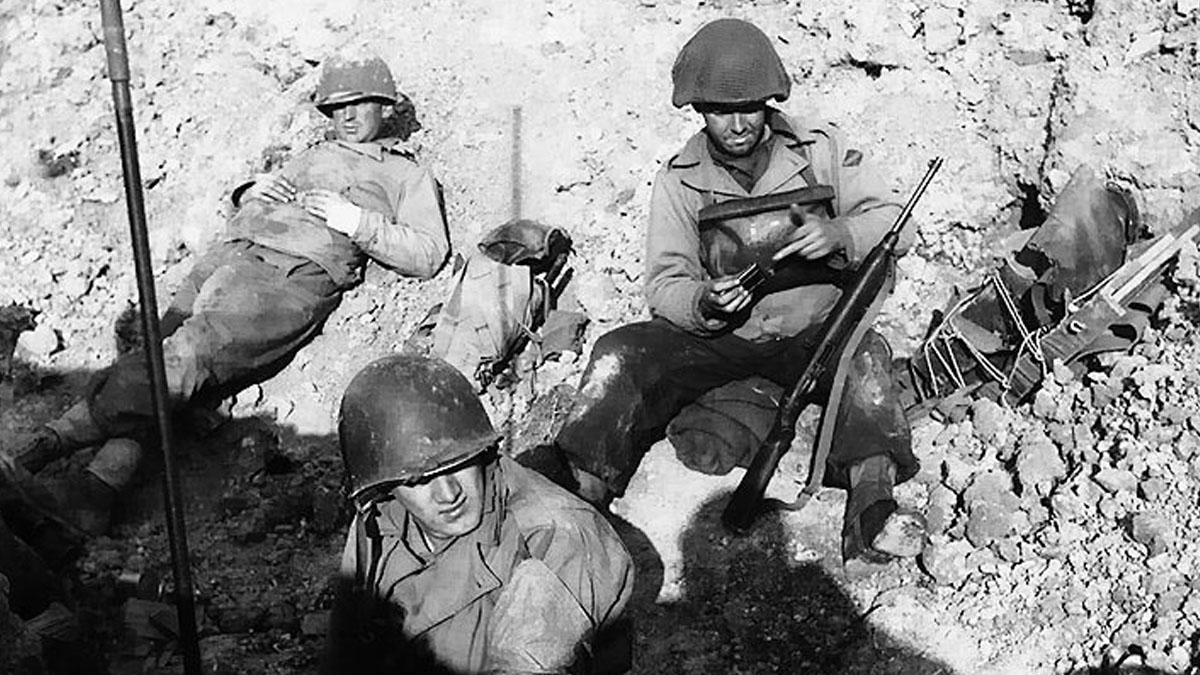Pointe-du-Hoc was one of the most fortified strongholds in the Nazi's Atlantic Wall. A bunker and gun emplacement at a height of between 85 and 100ft it overlooked the English Channel, Utah Beach, and Omaha Beach.
The base of the cliffs is a small, rocky beach that would offer no protection to the invading infantrymen. Today, it’s a popular site with visitors to Normandy. You can still walk the underground corridors, explore the gun pits and craters from the 1944 conflict. The landscape now is often described as “lunar” due to the battle scars.
German preparations at Pointe-du-Hoc
The guns at Pointe-du-Hoc belonged to the French. Nazi troops commandeered them after occupation but they first saw action in World War One. The GPF 155mm guns stood in open-top concrete pits until 1943. Then, 2nd Coastal Artillery Regiment and 352nd Infantry Regiment strengthened the position.
In the Spring of 1944, the German army began improving defences, anticipating the Allied invasion. They built an H636 observation bunker and six concrete casemates over the guns. This construction still wasn’t complete in June 1944 when the Rangers assaulted the cliffs. Had it been complete, it would have covered Utah Beach and Omaha Beach with a range of 25,000 yards.
In April 1944 the German army removed the guns for safe-keeping as Allied air forces bombed the area. Allied intelligence was unaware of this until the US Army Ranger Battalions scaled the 100ft cliffs at Pointe-du-Hoc on 6th June 1944.
Taking The German Battery
Lieutenant Colonel James Earl Rudder took command of the 2nd Ranger Battalion on D-Day. The mission was to land at 0630hrs, scale the cliffs and disable the German positions. Companies D, E, and F would scale the cliffs. Lieutenant Colonel Max F Schneider’s 5th Ranger Battalion and companies A and B of the 2nd would follow them in and reinforce. The first US Ranger Battalion had formed in Carrickfergus, Co. Antrim in 1942.
The secondary aim was the move inland and cut the coastal highway between Grandcamp and Vierville. The US 116th Infantry were to relieve them on arriving from Omaha Beach at 1200hrs on 6th June. These forces were to link up, move to Grandcamp and Maisy and join forces from Utah Beach.
During D-Day, the USS Texas bombarded the battery at Pointe-du-Hoc. USS Texas had set off from Belfast Lough after a stirring speech from General Eisenhower in Bangor, Co. Down. Pointe-du-Hoc was also bombed by 18 medium bombers of the 9th Air Force.
Problems for the Rangers on Omaha
During the landings, there were many navigational and technical issues to contend with. This set back the attack and left some troops out on their own. Some Rangers battalions arrived further down Omaha Beach, missing the cliffs and Pointe-du-Hoc completely.
Flares, radios, and other equipment failed and as the Rangers scaled the rock face they could not have known things would get much worse.
The element of surprise was on the side of the US Rangers. Because the cliffs were almost impregnable, the Germans focused their defences inland. The 716th Infantry Division stretched along 30 miles of the Normandy coast. 125 infantrymen and 85 artillery protected the Pointe-du-Hoc garrison.
D-Day at Pointe-du-Hoc
The US Rangers approached the point at 0630hrs on 6th June 1944. They had a flotilla of ten landing craft and four DUKWs. Rough seas sank one landing craft and a one supply craft. In the chaos and with a strong tide, the Rangers came ashore near Pointe de la Percée. This was over three miles east of Pointe-du-Hoc. As they traveled west, they lost another DUKW to 20mm fire.
Early in the day, the Rangers were already 35 minutes behind schedule. This allowed the Germans to return to their defensive positions after the initial aerial bombardment. The main Ranger force waited until 0700hrs without hearing back from the 2nd. As instructed they then landed west of Omaha leaving Rudder’s Rangers alone at Pointe-du-Hoc.
The remaining Rangers headed for the eastern cliffs rather than attacking from both sides as planned. Firing rocket-powered grappling hooks and using fireman ladders on the DUKWs was to aid the rappelling. Rubble from the bombardment piled up at the cliff base prevented the DUKWs from getting close enough to be of any use. But, it did give the men shelter and a higher starting point.
Mission accomplished
The 2nd US Ranger Battalion reached the top with only 15 casualties to find the gun emplacements empty. Telephone poles had taken their place and Rudder split his troops, sending a group to find the missing guns. The German infantry had hidden the guns in a nearby orchard. Rudder’s Rangers destroyed them with thermite grenades and the first goal was achieved.
The German 916th and 726th regathered and counter-attacked through the day. By nightfall, the Rangers were forced into a 200-yard wide defensive position holding the battery. Ammunition had run low and one-third of Rudder’s men had been lost.
By the following morning, fewer than 100 of General Rudder’s 225 men were able for battle. It would be a further 24 hours before the 5th Ranger Battalion would make the 4-mile journey to relieve them. They were almost two days behind schedule.
By 8th June 1944, the 2nd US Ranger Battalion had suffered 70% casualties but held off five German counterattacks. Rudder gained a Distinguished Service Cross for his role at Pointe-du-Hoc and would later command 109th Infantry Regiment.
Remembering the Rangers
The Pointe-du-Hoc Ranger Monument stands on top of the cliffs taken by Rudder’s men on 6th June 1944. It consists of a granite pylon blade pointing skywards and uses a concrete German bunker as its base. Tablets inscribed in both French and English pay tribute to the Rangers’ heroic actions.
Other than the monument, the battle-scarred landscape is much the same today as when the Rangers held the ground in 1944. This post makes up part of our travel diary from the 70th-anniversary of D-Day in Normandy 2014.
